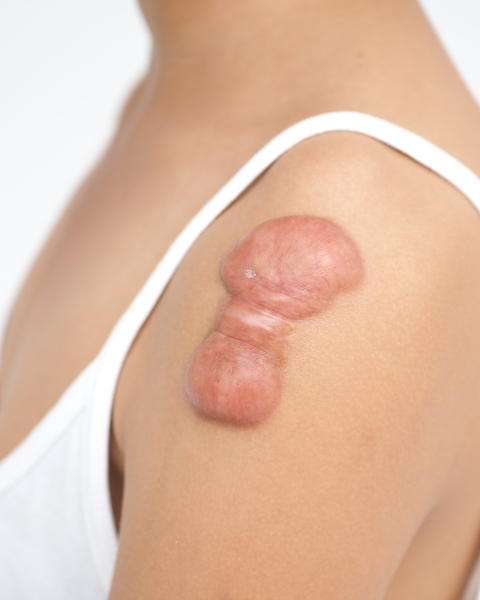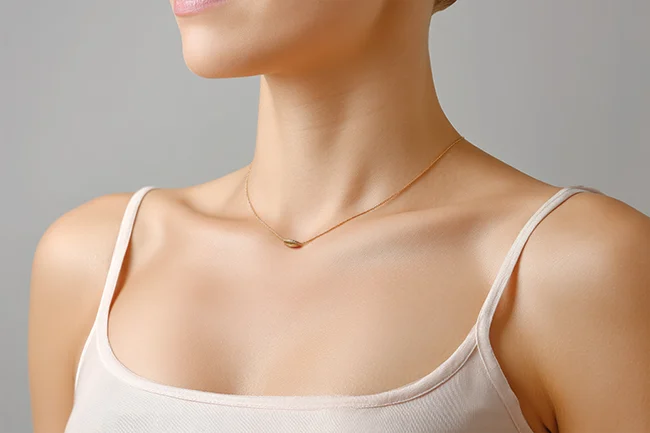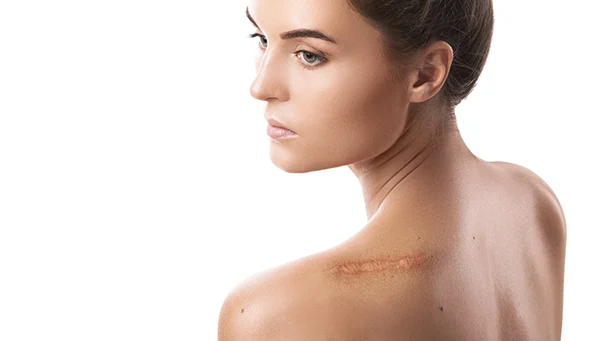Say goodbye to painful, itchy, or embarrassing keloids. As a board-certified plastic and reconstructive surgeon, Dr. Ryan Couvillion is highly experienced in treating complex keloids using advanced surgical and non-surgical techniques. Whether your keloid developed after surgery, trauma, burns, or acne, he offers personalized care that goes beyond aesthetics to relieve symptoms, restore comfort, and help you feel confident in your skin again.
Houston’s Trusted Expert for Keloid Treatment
Keloids are raised, thickened scars that grow beyond the boundaries of a skin injury. Unlike typical scars, they may continue to grow over time, become painful or itchy, and often cause distress—especially when visible or located in sensitive areas.
Keloids can form after:
- Cuts, burns, or surgical incisions
- Acne or piercings (especially on the ears)
- Inflammatory skin conditions
- Minor skin trauma in predisposed individuals
Some people are more genetically prone to developing keloids, especially those with darker skin tones.


Treatment Options for Keloids
Dr. Couvillion customizes treatment based on your keloid’s size, location, and history. He often combines approaches to reduce recurrence and improve long-term outcomes.
Surgical Removal
Surgical excision is often the most effective option for large, symptomatic, or previously treated keloids. Dr. Couvillion uses refined plastic surgery techniques to carefully remove the keloid while minimizing trauma to surrounding skin. He may pair surgery with steroid injections or other therapies to reduce the risk of recurrence.
Nonsurgical Treatments
- Steroid or 5-FU Injections: Reduce inflammation, flatten scar tissue, and relieve symptoms.
- Pressure Therapy or Silicone Sheets: Help soften and prevent regrowth.
- Cryotherapy or Laser: Occasionally used in select cases to shrink smaller keloids.
What Are the Benefits of Keloid Treatment?
- Relieves itching, tenderness, and skin tightness
- Improves appearance and self-confidence
- Reduces risk of continued keloid growth
- Allows better movement in affected areas
- Provides long-term or permanent resolution in many cases


Who Is a Candidate for Keloid Removal?
You may be a candidate if you:
- Have a visible or symptomatic keloid that causes discomfort
- Are unhappy with the size, location, or appearance of your scar
- Have tried steroid injections or other treatments without success
- Want expert care for recurring or difficult keloids
Dr. Couvillion will evaluate your scar, medical history, and treatment goals during your consultation to recommend the best path forward.
Preparing for Keloid Treatment
Before your procedure, Dr. Couvillion and his team will walk you through every step of the process. Preparation may include:
- Discontinuing certain medications or supplements
- Avoiding sun exposure to the treatment area
- Creating a post-treatment care plan (e.g., silicone sheets or pressure dressings)
If surgery is planned, you’ll receive pre-op instructions and support from our team.

What to Expect During Keloid Removal
Most procedures are performed in-office or outpatient surgical settings, depending on the keloid’s size and location.
- Anesthesia: Local anesthesia injections
- Procedure Time: Usually 30–90 minutes
- Closure: Often keloids are removed in a shave fashion and do not require stitches
- Downtime: Minimal, though protective dressings may be used
- Follow-Up: May include steroid injections, pressure therapy, or monitoring

Recovery and Long-Term Care
Dr. Couvillion prioritizes not just removal, but long-term prevention. Recovery support may include:
- Wearing compression earrings or garments (for ear or chest keloids)
- Using scar gels, tapes, or silicone sheets
- Post-op steroid injections to prevent recurrence
- Monitoring over 3–6 months for signs of regrowth
You’ll receive ongoing guidance and access to our team for questions and adjustments.
Frequently Asked Questions About Keloids
Will the keloid come back after surgery?
There is always a risk of recurrence, but Dr. Couvillion uses proactive techniques—including steroid injections and pressure therapy—to reduce that risk.
What’s the difference between a hypertrophic scar and a keloid?
Hypertrophic scars stay within the injury’s borders and may improve over time. Keloids grow beyond the original wound and typically don’t resolve on their own.
Can you remove a keloid from a previous piercing?
Yes. Ear keloids are the most common type Dr. Couvillion treats, and he often combines excision with compression therapy to reduce recurrence.
Is keloid removal painful?
Most patients experience only mild discomfort. Local anesthesia is used for in-office excisions and most patients do not need any medications after the procedure.
Can I prevent future keloids?
If you’re prone to keloids, it’s best to avoid unnecessary skin trauma (like new piercings or tattoos) and let your provider know before any surgery. Early treatment of any developing keloid is key.
Get Relief From Keloids With Dr. Couvillion
Don’t let a keloid hold you back. Whether it’s affecting your comfort, confidence, or quality of life, Dr. Couvillion is here to help with expert guidance and compassionate care.

Dr. Couvillion is very gifted. I am extremely pleased with my results. Still smiling about it every day. I was taken very good care of by staff and Dr. Couvillion and would definitely recommend a consult!
– Patient, Google Reviews
